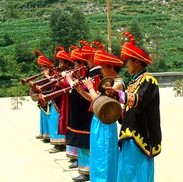Yi Suona overview
 The Yi nationality suona (pinyin: yí zú suǒ nà) is a double-reed gas-sounding instrument of the Yi nationality. In Yi language, they are called Mohe, Mohong, Bailai, Zenai, etc. Because the whole body is made of wood, it is also known as the Yi wooden suona. Popular in Weining, Bijie, Liupanshui, Guizhou Province and Ganluo, Xide, Butuo, Liangshan Yi Autonomous Prefecture, Sichuan Province.
The Yi nationality suona (pinyin: yí zú suǒ nà) is a double-reed gas-sounding instrument of the Yi nationality. In Yi language, they are called Mohe, Mohong, Bailai, Zenai, etc. Because the whole body is made of wood, it is also known as the Yi wooden suona. Popular in Weining, Bijie, Liupanshui, Guizhou Province and Ganluo, Xide, Butuo, Liangshan Yi Autonomous Prefecture, Sichuan Province.The shape is more simple and bigger than the ordinary copper bowl suona. It consists of a reed whistle, a core, a tube body and a horn. Sizes vary, the smaller ones are about 45 cm high, the larger ones can reach 90 cm, and the common ones are about 72 cm high. A reed whistle is a double-reed whistle made of reed or straw, about 2 cm long. The core is made of wooden sticks or copper sheets, the top is thin and the bottom is thick, and it is a conical tubular body. Two is one, the outer diameter and height are about 5 cm, there is an intubation tube in the middle to place the reed whistle, and the lower end is inserted into the tube head. The tube body is mostly made of mahogany, pear wood or chun wood. The tube length is about 45 cm, and the outer diameter of the tube tail is 2.4 cm. There are seven or eight circular sound holes on the tube body. Seven holes have no back holes, and eight holes The eighth hole is the back hole with a diameter of 0.6 cm. The lower end of the tube body is covered with a trumpet made of chun wood or palm tree rod.
When playing, hold the pipe upright, support the pipe with both hands, press the thumb of the right hand with the back hole, the index finger, middle finger, and ring finger with the three holes on the front, and the index finger, middle finger, ring finger, and little finger of the left hand with the four holes on the front. The mouth contains a reed whistle, played with the cyclic ventilation method, the range is a-a?2, and there are two octaves. The pronunciation is softer, the volume is louder, and the tone is rich. Can be used for solo, unison or instrumental ensemble. The Yi family often used two suonas with the same pitch to play together. When playing the mid-range melody, the two suonas played in unison; when playing the high-pitched melody, one suona played the lower octave. The method of playing high and low octaves respectively is "inverted". During festivals or weddings and funerals, the Yi people invite folk artists to play suona, often accompanied by small leather drums, cymbals and other musical instruments.
- Chinese name:Yi Suona
- type:Yi nationality double-reed air-sounding instrument
- alias:Mo He, Mo Hong, Bai Lai, Ze Nai, etc.
- Pinyin:yí zú suǒ nà
overview of other similar instruments
- sanyanxiao overview
- Daguangxian overview
- Leiqin overview
- hahao overview
- yandundagu overview
- Han Xiaozheng overview
- Fang Xiang overview
- guanzi overview
- zhuqin (Dao Qin) overview
- zhuiqin overview
- bangzi overview
- three-stringed piano overview
- Gehu overview
- xiao overview
- xiaokonghou overview
- Konghou overview
- Sheng overview
- suona overview
- hulusi overview
- gushao overview
 渝公网安备 50010702504639号
渝公网安备 50010702504639号